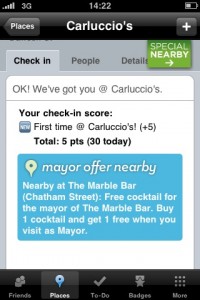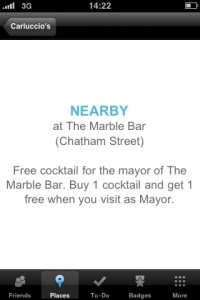This is a guest post from Aaron McKenna who is the Country Manager for Komplett.ie, the Norwegian electronics etailer. Komplett launched a social media marketing campaign in May 2009. In this guest post, Aaron will discuss some of the elements relating to their experiences and lessons learned since then. This is a blueprint on how to do business online using social media. Download, print, send on and share with as many people as you can.
Komplett will make a high six figure sum out of social media marketing in Ireland in 2010, having made a modest six figure sum in 2009. By 2011 it will be seven. I don’t joke. I was reading an article in the latest BusinessWeek talking about social media consultants being the equivalent of snake oil salesmen in some senses: Extolling the mantra of social media as gospel, adhering to strict doctrines about ‘the conversation’ and selling many companies just that; expensive snake oil.
Personally, I’ve decided to class myself as a ‘sceptical convert’ to the idea of Social Media Marketing.
I’m a convert because we’re actually making money out of it. It’s driving revenue. There are results beyond how many followers we get, and impressions to our blog. These are nice things to have, and the brand value of our exercise is quite important… But at the end of the day, there has to be a bottom line result; and the word ‘results’ is something I find a lot of marketing agencies and consultants tend to shy away from when you quantify those results on the bottom line.
Yes the money is, in the grand scheme of things, not a massive amount of our total turnover… But another good piece of advice on business is, it’s a game of inches; and social media marketing for us has been quite cheap all things considered. And the potential I see for it is much broader than what it stands at today.
I’m a sceptic because I inherently mistrust anything that every business consultant looking for my cash is extolling the virtues of. The first thing I look at in any business/marketing consultant is how many successful businesses/marketing campaigns they’ve run, barring their consultancy. It’s low, for many of them, and I mistrust mostly their lack of understanding of the day-to-day fundamentals that business leaders have to deal with.
I remain committed to growing our social media efforts whilst in the back of my head wondering how much of this is a fad or a bubble. Surely some of it must be, I think…
But the trick to succeeding in the long run will come in being strong in the areas that will stand the test of time and still be around in five years. Not just platforms, but modus. I truly believe that you have to add value to reap success in this medium – Setting up a Twitter account, getting 10,000 followers and spamming them with ‘deals’ all day long; or talking about the weather outside your office, these things do not add value.
Adding value is writing ‘How-To’ articles for the DIY products you sell (in our case, computer components) and being around to answer questions for people on the fly. It’s hotels giving me a great guide for the locality so as I know where to go and what to do within easy striking distance of the lobby when I arrive for an overnight business trip. It’s being able to tweet the reception to say what time I’ll arrive because of a flight delay, and getting asked how it went in the end when I finally arrive.
The second lesson I have after adding value concerns the bottom line: It’s something that is often left out of discussions regarding social media marketing, whereas in my view and, I think, in yours too it is a central concern. How much money can I make out of social media, when and how?
While our circumstances and experience sure as heck won’t be yours, I find value in reading the stories of other businesses and applying my own lens to it.
The Beginning
We kicked off in social media marketing for four main reasons:
- 1. We’re a web company, and web based marketing reaps direct results in a playing field we’re suited to
- 2. Social media has been on the rise for some time now, and all that noise warranted some exploration
- 3. Yours truly originally comes with a background in online media, and so you could say I have a bias towards this field (and knowledge of how to make it work) that aided our decision to explore it
- 4. It’s cheap. Let’s face it, we’re all looking for the cheapo marketing option, and till now our social marketing campaign has cost us, per month, less than the cost of an advertisement, just one ad, in many magazines and newspapers
We tested the waters a little with some not very convincing and sporadic content for a few weeks, kicking the tyres, picking platforms and seeing how they work – A blog, Twitter and Facebook were chosen as our three main avenues of attack.
Bebo is popular in Ireland, but not amongst our audience – though not to say we’ll never go there. LinkedIn and other services like that have value, but focusing on them takes more resources and doesn’t provide enough value, so I made the decision that we should focus our efforts on these three platforms.
This, I suppose, could be a lesson pulled out for you right here: No matter what the mediums you choose, and the way you choose to approach them, you need to be able to focus daily attention to them. Spreading yourself too thin reaps poor rewards in all channels.
Finding A Strategy
After a while, having spent no money and a little time on the effort, I figured there was something in it and we’d need a strategy. Obviously it needed a strong ‘social’ element, with us becoming more active on Twitter and Facebook and growing our audience there… But I still needed to find the ‘Something’ that would add value and give people a reason to participate with us beyond our charm and good looks.
At the time we were running a fairly popular campaign, doing free ‘Build Your Own PC’ classes in our office on a Saturday morning. (A campaign that will see light again in 2010, incidentally. We’re working on ways to bring it to a wider audience.) A clear value add: We teach you how to build your own PC and you’re more likely to do it, and shop with Komplett because you know us – we’re the guys who taught you how to do it!
It doesn’t take a genius (which is fortunate, considering I was the guy doing the figuring) to figure out that we could make a jump into offering how-to content online via the blog. A phone call later and Marc McEntegart, a henchman from my days in media, was sat in my office and we discussed ways to shape it. The idea of how-to and technical content was my idea, as was the evolution from this into writing up product spots and doing deals. Marc came up with the idea of filling in the middle with tech news and general articles, growing our traction with a reader base whom we could later convert into customers.
He – and here’s another lesson – is also a sociable fellow. Take a look at us on Twitter, on boards.ie, and the general tone of many of our blog articles. You ideally need a good communicator to front your social efforts. An introvert won’t cut it. Sounds silly, but there you go. Someone with tact is a bonus, too.
Our content heavy model won’t suit every business, but we spotted a gap (localised Irish how-to and technical content), and invested a near FTE into the effort… A big toe dipped in.
The flipside from the content on the blog – which we see as the anchor to our social media operation – is the communication channels, Twitter and Facebook. Here we’ve developed an offering tailored to the medium, becoming extremely chatty and friendly with people on Twitter, where constant conversation is the norm; and less sporadic updates to Facebook of the most interesting blog content.
So the ‘workflow’ of our social media campaign involves Twitter and Facebook conversations ultimately driving traffic to our blog, where the greatest value-add resides in terms of content; and from the blog we eventually convert customers with quality, useful content, like how-to’s and product spots highlighting what we think is interesting and why.
Not That We Forgot About The Conversation…
The blog is the anchor of our social media campaign, and it eats up the most time and resources. Our main focus is to drive people to the blog where we hook them with really useful and honest content.
That’s not to say that we think Twitter and Facebook are a means to an end. These, particularly Twitter, are places where we see a huge level of engagement with people on a daily basis; from answering questions about products to more social banter.
This engagement in conversation, be it with or without a blog, is extremely useful: For starters, we’ve got some of our best feedback from customers through this avenue. It’s a live finger on the pulse, and it’s proved useful to us on many practical levels… Including feedback from folks telling us that something in the webshop is broken and needs to be fixed, long before we would have ever noticed it.
How Do I Gain Traction?
No matter your strategy, be you tweeting alone or creating compelling content every day, you need to gain traction with your audience. Once you’ve hooked a customer into your social web – be they conversing with you on twitter or following your content via RSS or whatever – you can pretty much count on their loyalty, so long as the content remains good.
Komplett launched its non-traditional social media marketing campaign with a fairly traditional trick: we ran a competition for people following us on Twitter and Facebook, giving away a bunch of free games. Now, there is a discussion here about quantity versus quality in terms of your following: It’s relatively easy to get a thousand eyeballs on the internet. But quality eyeballs?
To my view, quality is all that matters – the customers we attract (for Komplett) have to be Irish (we’re an Irish webshop); they have to be web shoppers or people open to the idea of shopping online (believe you me, they’re not a wide grouping in Ireland per capita today); and buying the kind of stuff we sell: Computer components and consumer electronics. Whatever your audience profile, you need to target this group.
So, on the face of it is a competition going to generate quality followers for us? Depends on the competition. Our video game one was a bit of a wide net to cast, but we went about promoting it in targeted haunts – Damien here gave it a plug for us, and his audience would be right up our alley. We pushed it on boards.ie where we have a long-standing customer interaction forum (their biggest… I say to social media heads sometimes that we’re probably the oldest Irish company with a social presence on the web); and so the potential net was wide, but the delivery method was not.
You do need something to get you some buzz to get some traction – be it a targeted competition (the easiest route) or something more elaborate – and after that, the audience will grow itself slowly but steadily. Always focus on that: Slow but steady. Quality. Once you get in a few dozen eyeballs, they’ll begin to spread your stuff around and you’ll grow steadily.
The Salacious Relationship: Social Media And Money
As I mentioned above, many marketing agencies and consultants don’t like to talk money. (Not in terms of results, at least.) Particularly in the context of social media. It’s sometimes difficult to reconcile yourself against being social and honest and opening people’s wallets. Brand awareness, brand value, buzz, goodwill, word of mouth… All great words and phrases, but the majority of you out there (I’ll bet) are just like me: fighting for your lunches. Fighting for customers, conversions, sales and, ultimately, to keep a chair under your arses.
In the daily reality, you need a dual-band approach: All the buzzwords do translate into real value for your company. All that goodwill generated from all those people you’re tweeting with or from that funny video you threw up on YouTube is worth something to you: Branding, customer loyalty, whatever. But this isn’t always a result directly seen on the bottom line today, unless you’ve got an eye towards driving sales as well.
Focus too much on one aspect and you won’t go very far, at least not very fast – schill too much for sales and you’ll alienate people. Make them feel good about themselves, great, but where’s the call to action to make a sale?
Short term revenues matter. So does long term customer relationships. But you need to eat your lunch this afternoon. Social media, to my mind, should be about getting you a sandwich today and building the kind of relationship that delivers a big turkey every Christmas.
How do you achieve this? Every industry and business will have a different answer. (It’s my hope that in reading this, of course, you see my logic and twist it to your circumstance.) For Komplett the answer comes through our business model obviously, we’re an online retailer, so we give you content about our products; making the most of them and what have you; and people buy stuff.
The relationship we forge brings them back: That relationship of trust between you and Komplett, that says we’re a human company that wants to do good by you. If we simply generated that goodwill we’d get sales, eventually… But there needs to be the call to action today.
If you’re a hotel and tweeting me on my journey, you’ll likely get the goodwill to bring me back next time. But how did you ensnare me the first time? Good content? A pre-sales conversation about the area the hotel is in, and what I can do around it?
What can you offer your customers, and where’s the call to action?
And what kind of results can you expect? For me, a quarter million added to the bottom line is alright, I suppose, a few percentage points, not worth a bankers bonus for sure. I won’t turn my nose at it. But I could make a half million in once off sales to a particular group of people if I invested time into it… So where’s the long term payoff in social media?
Well, that quarter million represents customers who are most certainly satisfied and will likely be loyal to Komplett; they may even tell all their friends about us. I need the quarter million today, the couple of million tomorrow, to justify the investment in time and effort in social media… But the long term takeaway, the thing that the social media consultants like to extol the virtues of, is still there; and that will build your business for the long term.
Depending on your business the fundamental numbers will be different. Five thousand or fifty thousand or fifty million, it doesn’t matter, it’s marketing 101 as to defining success: If you’re a hotel (sorry, I’ve got hotels on the brain today) and you follow my advice and offer content, how many hits do you get on that content a month? What’s the click through rate to your online booking form? What’s the conversion? The average order value? Wham, bam, thank you ma’am.
The long term virtue of the relationship with that customer is obvious. But the key is you just made some cash out of them today. That’s critical. And yes, tomorrow or the next day you might get the other people who took a peek and decided not to buy… But I’ll bet your boss (or bank manager) looks at the figures for customers who pulled the trigger, not the ones who played with the pistol and might come back tomorrow.
Dip your toes in. Define your strategy, and your criteria for success. Invest in it, you’ll spend money before you make it. If you’re not being successful, tweak it. Eventually you’ll get there. My recommendation is to drag in guys like Damien once you’ve figured out your criteria for success at different investment levels. Give the consultants a clear framework and they’ll bring excellent value to your efforts, defining routes to achieving the success you’ve defined, not some vague definition of it taken from the social media bible.
Social media marketing is new, it’s going to evolve tremendously in the years to come in terms of platforms, methods and tools (I already see people creating tools to track down potential sales leads on the social networks); but like any other investment you make in time or money, it needs to deliver money today as well as the long term promised value of customer loyalty and brand awareness.
—
On Twitter: Aaron McKenna






